สิ่งมีชีวิตใต้ทะเลเกาะช้าง – ดำน้ำแล้วจะเจออะไรบ้าง?
สำรวจ จุดดำน้ำรอบเกาะช้าง แนวปะการังสีสันสดใส และสิ่งมีชีวิตใต้ทะเลหลากหลายชนิด เรามี ทริปดำน้ำและดำน้ำตื้นทุกวัน ไปยังจุดที่ได้รับความนิยมสูงสุดในอุทยานแห่งชาติหมู่เกาะช้าง
บนโลกมีปลาประมาณ 21,000 สายพันธุ์ การจำแนกประเภทใช้ลักษณะทางกายภาพ เช่น รูปร่าง สี และขนาด ระหว่างดำน้ำ – ไม่ว่าจะเป็น Try Dive หรือ หลักสูตรขั้นสูง – เราจะเคลื่อนไหวช้าๆ ตามแนวปะการังเพื่อสังเกตและบันทึก
ทั้งที่ จุดดำน้ำเรือจม และแนวปะการัง เราพบปลาหลากหลายสายพันธุ์ หากไม่สามารถระบุได้ เราจะวาดภาพคร่าวๆ และเปรียบเทียบกับหนังสืออ้างอิง การสังเกตและรายงานการเปลี่ยนแปลงเป็นสิ่งสำคัญในการปกป้องระบบนิเวศใต้น้ำที่เปราะบางนี้
🧭 พร้อมสำรวจโลกใต้น้ำที่เกาะช้างหรือยัง?
เข้าร่วม ดำน้ำสนุก หรือเลือก คอร์สดำน้ำ กับเรา แล้วค้นพบความงามของสิ่งมีชีวิตใต้ทะเลเกาะช้าง อุปกรณ์มีให้ครบ – หรือดู อุปกรณ์ดำน้ำ ของเราได้เลย!
สัตว์เลี้ยงลูกด้วยนม
สัตว์เลี้ยงลูกด้วยนม รวมถึงมนุษย์และสัตว์ชนิดอื่นๆทั้งหมด เป็นสัตว์ที่มีกระดูกสันหลังและมีเลือดอุ่น เลี้ยงลูกด้วยน้ำนม และมีสมองที่พัฒนาดีกว่า สัตว์ประเภทอื่นๆ
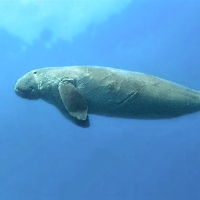
พะยูน
ขนาด: 4เมตร / พบเห็นได้ยาก / พฤติกรรม: เฉยเมย / มีอายุได้ 73 ปี

โลมาหลังโหนก หรือ โลมาสีชมพู
ขนาด: 3.2เมตร / พบเห็นได้บางครั้ง / พฤติกรรม: หวาดระแวง / มีอายุได้ 50 ปี

โลมาอิระวดี
ขนาด: 2.75เมตร / พบเห็นได้บางครั้ง / พฤติกรรม: อยากรู้อยากเห็น / มีอายุได้ 28 ปี

โลมาสปีนเนอร์ หรือ โลมากระโดด
ขนาด: 2.4เมตร/ พบเห็นได้บางครั้ง / พฤติกรรม: หวาดระแวง / มีอายุได้ 50 ปี
ฉลาม และ ปลากระเบน
ฉลาม และ กระเบน เป็นสิ่งมีชีวิตที่ลึกลับ และเป็นสัตว์ที่ถูกมนุษย์เข้าใจผิดๆ เกี่ยวกับชีวิตของพวกมันมากที่สุดในมหาสมุทร พวกมันมีความสำคัญต่อระบบนิเวศของโลกของพวกเรา ฉลามและกระเบนช่วยโลกต่อสู้กับการเปลี่ยนแปลงสภาพภูมิอากาศโลก,ด้วยการรักษาระบบนิเวศห่วงโซ่อาหาร แบ่งปันอาหารกับเพื่อนบ้านของพวกมัน เพื่อการเจริญเติบโตของแพลงก์ตอนและพืชพืช

ฉลามวาฬ
ขนาด: 12เมตร/ พบเห็นได้บางครั้ง / พฤติกรรม: เฉยเมย / มีอายุได้ 100 ปี

ฉลามปะการังสีเทา
ขนาด: 2.55เมตร/ พบเห็นได้ยาก / พฤติกรรม: อยากรู้อยากเห็น / มีอายุได้ 25 ปี/ ความเป็นอันตราย: ฟันแหลมคม
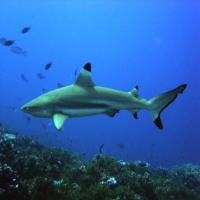
ฉลามหูดำ
ขนาด: 2เมตร / พบเห็นได้ยาก / พฤติกรรม: อยากรู้อยากเห็น / อายุขัย: 12 ปี / ความเป็นอันตราย: ฟันแหลมคม

ฉลามขี้เซา
ขนาด: 3.2เมตร / พบเห็นได้บางครั้ง / พฤติกรรม: เฉยเมย / ความเป็นอันตราย: ฟันแหลมคม

ปลากระเบนนก
ขนาด: 1.5เมตร / พบเห็นได้ยาก / พฤติกรรม: เฉยเมย

กระเบนจุดฟ้า
ขนาด: 70เซนติเมตร/ พบเห็นได้บ่อย/ พฤติกรรม: เฉยเมย
ปลากระมง
ปลาโมง หรือ ปลากระมง หรือ ปลากะมง ยังเป็นที่รู้จักกันชื่อ Jack Fish, ปลาสีขนเกาะ, ปลาตะคอง เป็นปลาสายพันธุ์ใหญ่ของปลาทะเล ปลาชนิดนี้กระจายอยู่ทั่ว ในเขตร้อนและเย็น

ปลากระมงยักษ์ หรือ กะมงพร้าว
ขนาด: 1.7เมตร/ พบเห็นได้ยาก / พฤติกรรม: หวาดระเเวง / มีอายุได้ 20 ปี

ปลาตะคองเหลือง
ขนาด: 1.2เมตร/ พบเห็นได้บ่อย / พฤติกรรม: อยากรู้อยากเห็น/ มีอายุได้ 20 ปี
ปลาหูช้าง และ ปลาชายฝั่ง
ปลาชายฝั่ง หรือที่เรียกว่าปลาเขตน้ำตื้น อาศัยอยู่ในทะเลระหว่างชายฝั่งและขอบของไหล่ทวีป เนื่องจากไหล่ทวีปมักจะลึกน้อยกว่า 200 เมตร ปลาชายฝั่งทะเลมักเป็นปลาซึ่งอาศัยอยู่ในเขต ท้องทะเลตื้นที่มีแสงแดดส่อง ตรงกันข้ามกับปลาในมหาสมุทรหรือปลานอกชายฝั่งซึ่งอาศัยอยู่ในทะเลลึกเกินกว่าไหล่ทวีป

ปลาหูช้างครีบยาวอกดำ
ขนาด: 70เซนติเมตร / พบเห็นได้บ่อย / พฤติกรรม: อยากรู้อยากเห็น
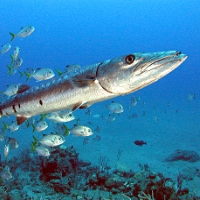
ปลาสากบั้งหางดำ
ขนาด: 1.7เมตร / พบเห็นได้ทั่วไป / พฤติกรรม: เฉยเมย / ความเป็นอันตราย: ฟันแหลมคม

ปลาสากเหลือง
ขนาด: 1.4เมตร/ พบเห็นได้ทั่วไป / พฤติกรรม: เฉยเมย

ปลาสากครีบดำ
ขนาด: 1.2เมตร/ พบเห็นได้ทั่วไป / พฤติกรรม: เฉยเมย

ปลากระทุงเหว
ขนาด: 60เซนติเมตร / พบเห็นได้บ่อย / พฤติกรรม: หวาดระเเวง

ปลากล้วยหางเหลือง
ขนาด: 60เซนติเมตร / พบเห็นได้มาก / พฤติกรรม: หวาดระเเวง
ปลาในเเนวปะการัง
ปลาในเเนวปะการัง เป็นปลาที่อาศัยอยู่ในหมู่ปะการังหรือใกล้ชิดกับแนวปะการัง แนวปะการังเป็นระบบนิเวศที่ซับซ้อนที่มีความหลากหลายทางชีวภาพอย่างมาก ในบรรดาสิ่งมีชีวิตที่อยู่อาศัยในแนวปะการังจำนวนมากนั้น ปลามีความโดดเด่นที่สีสันและความน่าสนใจ สัตว์หลายร้อยชนิดสามารถพบได้ในพื้นที่เล็ก ๆ ของแนวปะการังที่สมบูรณ์ หลายชนิดหลบซ่อนหรือพรางตัวได้ดี ปลาในแนวปะการังได้พัฒนาความสามารถพิเศษมากมายที่ปรับตัวให้เข้ากับการอยู่รอดในแนวปะการัง

ปลาสลิดทะเลเหลืองจุดฟ้า
ขนาด: 35เซนติเมตร / พบเห็นได้ไม่บ่อย / พฤติกรรม : เฉยเมย
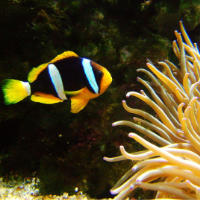
ปลาการ์ตูนปล้องดำ
ขนาด: 15เซนติเมตร / พบเห็นได้ไม่บ่อย / พฤติกรรม: เฉยเมย / มีอายุได้: 14 ปี

ปลาการ์ตูนไฟ
ขนาด: 12เซนติเมตร/ พบเห็นได้ยาก / พฤติกรรม: เฉยเมย /มีอายุได้: 5 ปี

ปลาการ์ตูนอินเดียนแดง
ขนาด: 11เซนติเมตร/ พบเห็นได้บ่อย / พฤติกรรม: เฉยเมย
ปลาสลิดหิน
ปลาสลิดหิน ประกอบด้วย วงศ์ปลาปลาสลิดหินทุกครอบครัวยกเว้นพวก จำพวกปลาการ์ตูน สายพันธุ์ที่ใหญ่ที่สุดสามารถเติบโตได้ถึง 36 เซนติเมตร(14 นิ้ว) แต่สายพันธุ์ส่วนใหญ่มีขนาดเล็กกว่ามาก ในขณะที่ส่วนใหญ่เป็นปลาทะเล, แต่ก็มีเพียงไม่กี่สายพันธุ์ที่อาศัยอยู่ตามแนวด้านล่างของแม่น้ำในน้ำจืด สายพันธุ์ปลาสลิดหิน ส่วนใหญ่มีสีสดใสหรือรูปแบบที่ตัดกัน

ปลาสลิดหินบั้งหกแถบ
ขนาด: 19เซนติเมตร / พบเห็นได้มาก / พฤติกรรม: เฉยเมย

ปลาสลิดหินสามจุด
ขนาด: 14เซนติเมตร / พบเห็นได้ทั่วไป /พฤติกรรม: ก้าวร้าว

ปลาสลิดหินลายนกยูง
ขนาด: 11เซนติเมตร / พบเห็นได้ทั่วไป / พฤติกรรม: เฉยเมย

ปลาสลิดหินแถบดำ
ขนาด: 6เซนติเมตร / พบเห็นได้ไม่บ่อย / พฤติกรรม: หวาดระแวง
ปลากะรังและปลาอมใข่
ปลาอมใข่ เป็นครอบครัว ปลาอมใข่ครีบยาวที่พบในมหาสมุทรแอตแลนติกอินเดียและมหาสมุทรแปซิฟิก ส่วนใหญ่เป็นปลาทะเล แต่บางชนิดพบได้ในน้ำกร่อยและบางชนิดพบในน้ำจืด มีไม่กี่ชนิดถูกเลี้ยงไว้ในตู้ปลาและเป็นที่นิยมในหมู่ปลาเลี้ยงขนาดเล็กและที่มีสีสัน สายพันธุ์นี้ประกอบด้วยประมาณ 370 ชนิด

ปลากะรังจิ๋วหลังจุด
ขนาด: 19เซนติเมตร / พบเห็นได้ไม่บ่อย / พฤติกรรม: เฉยเมย

ปลากะรังจิ๋วสีม่วง
ขนาด: 12เซนติเมตร / พบเห็นได้ไม่บ่อย / พฤติกรรม: เฉยเมย

ปลาอมไข่ส้มเหลือง
ขนาด: 8เซนติเมตร / พบเห็นได้ไม่บ่อย / พฤติกรรม: เฉยเมย

ปลาอมไข่ลายจุด
ขนาด: 8เซนติเมตร / พบเห็นได้ไม่บ่อย / พฤติกรรม: เฉยเมย
ปลากระรอก
ปลากระรอกเป็นปลาทะเล มีสีแดงเงิน,ลายที่ตัวสีส้มทอง ปลากระรอกมีประมาณ 150 สายพันธุ์ ลักษณะเด่นที่สุดคือตาโต และกระดูกที่ยาวของครีบทวารที่สาม อาศัยอยู่ในแนวปะการังในทะเลเขตร้อนและอบอุ่น และกินสัตว์ขนาดเล็กที่อยู่พื้นทะเลหรือปะการัง

ปลากระรอกครีบดำ
ขนาด: 35เซนติเมตร / พบเห็นได้ทั่วไป / พฤติกรรม: เฉยเมย

ปลาข้าวเม่าน้ำลึกทรงเหลี่ยม
ขนาด: 30เซนติเมตร / พบเห็นได้ทั่วไป / พฤติกรรม: เฉยเมย

ปลากระรอกสามจุด
ขนาด: 27เซนติเมตร / พบเห็นได้ทั่วไป /พฤติกรรม: เฉยเมย

ปลากระรอกหนามยาว
ขนาด: 17เซนติเมตร / พบเห็นได้มาก / พฤติกรรม: เฉยเมย
ปลานกขุนทอง
วงศ์ปลานกขุนทอง (Labridae) เป็นวงศ์ของปลาทะเลปลากระดูกแข็งวงศ์หนึ่ง มีสีสันสดใส สายพันธุ์นี้มีขนาดใหญ่และมีความหลากหลายมีมากกว่า 600 ชนิด มี 81 สกุล ซึ่งแบ่งออกเป็น 9 กลุ่มย่อย โดยทั่วไปแล้วจะเป็นปลาตัวเล็ก ๆ ซึ่งส่วนใหญ่ยาวน้อยกว่า 20 เซนติเมตร แต่ปลาขุนทองหัวโหนกจะตัวใหญ่ที่สุด สามารถวัดได้ถึง 2.5 เมตร พวกมันเป็นสัตว์กินเนื้อ ที่กินสัตว์ไม่มีกระดูกสันหลังขนาดเล็กหลากหลายชนิด.

ปลาขุนทองลาย
ขนาด: 45เซนติเมตร / พบเห็นทั่วไป / พฤติกรรม: หวาดระแวง

ปลานกขุนทองอาฟริกัน
ขนาด: 40เซนติเมตร / พบเห็นได้บ่อย /พฤติกรรม: อยากรู้อยากเห็น
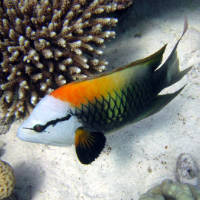
ปลานกขุนทองปากยืด
ขนาด: 54เซนติเมตร / พบเห็นอยู่ทั่วไป / พฤติกรรม: เฉยเมย

ปลานกขุนทองดินสอ
ขนาด: 50เซนติเมตร / พบเห็นอยู่ทั่วไป/ พฤติกรรม: อยากรู้อยากเห็น
ปลากะพง
ปลากะพง ใช้ชื่อวิทยาศาสตร์ว่า Perciformes (/เพอร์-ซิ-ฟอร์-เมส/) ซึ่งเป็นปลากระดูกแข็ง คิดเป็นร้อยละ 40 ของปลากระดูกแข็งทั้งหมด ลักษณะเด่นของปลาในอันดับนี้คือ เป็นปลากินเนื้อ เกล็ดมีลักษณะสากขอบเป็นหยักแข็ง ปากยาวมีลักษณะยืดหดได้ มีก้านครีบแข็ง หรือ Spine ที่ครีบหลังตอนหน้า พบได้ทั้ง น้ำจืด , น้ำกร่อย และทะเล

ปลากระพงแดงหน้าตั้ง
ขนาด: 1.16เมตร / พบเห็นได้ยาก / พฤติกรรม: หวาดระแวง / มีอายุได้: 35 ปี

ปลากระพงปากแม่น้ำ
ขนาด: 1.2เมตร / พบเห็นอยู่ทั่วไป / พฤติกรรม : หวาดระแวง /มีอายุได้: 35 ปี

ปลากระพงครีบยาว
ขนาด: 60เซนติเมตร / พบเห็นได้ยาก / พฤติกรรม: หวาดระแวง

ปลากระพงเหลืองสายฟ้า
ขนาด: 40เซนติเมตร / พบเห็นได้บ่อย / พฤติกรรม: เฉยเมย
ปลาสร้อยนกเขา
ปลาสร้อยนกเขาทะเล, มีสีสันสวยงาม เป็นสายพันธุ์ที่มีถิ่นกำเนิดในมหาสมุทรอินเดียและมหาสมุทรแปซิฟิกตะวันตก อาศัยอยู่ในแนวปะการังที่ระดับความลึกตั้งแต่ 1 ถึง 30 เมตร

ปลาสร้อยนกเขาดอกดำ
ขนาด: 72เซนติเมตร / พบเห็นอยู่ทั่วไป /พฤติกรรม: เฉยเมย

ปลาสร้อยนกเขาลายตรง
ขนาด: 72เซนติเมตร / พบเห็นได้ยาก / พฤติกรรม: เฉยเมย
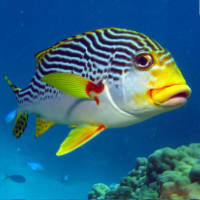
ปลาสร้อยนกเขาลายทะเเยง
ขนาด: 72เซนติเมตร / พบเห็นได้ยาก / พฤติกรรม: เฉยเมย

ปลากระพงเส้นเหลืองข้างปาน
ขนาด: 35เซนติเมตร / พบเห็นอยู่ทั่วไป /พฤติกรรม: เฉยเมย / มีอายุได้: 23 ปี
ปลาหมูสี
หรือปลาตะมะ หรือที่รู้จักกันทั่วไปว่า ปลาหมูสี ปลาเหล่านี้พบในน่านน้ำเขตร้อนของมหาสมุทรแปซิฟิกและมหาสมุทรอินเดีย และ ปลาหมูสี ยังพบได้ในมหาสมุทรแอตแลนติกตะวันออก

ปลาหมูสีหน้ายาว
ขนาด: 1เมตร / พบเห็นอยู่ทั่วไป / พฤติกรรม: หวาดระเเวง
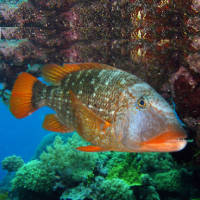
ปลาหมูสี
ขนาด: 90เซนติเมตร / พบเห็นอยู่ทั่วไป / พฤติกรรม: หวาดระเเวง

ปลาหมูสีข้างปาน
ขนาด: 50เซนติเมตร / พบเห็นอยู่ทั่วไป / พฤติกรรม: หวาดระเเวง อายุขัย: 15 ปี

ปลาหมูสีเล็กเส้นเหลือง
ขนาด: 30เซนติเมตร / พบเห็นไม่บ่อย / พฤติกรรม: เฉยเมย
ปลากะรังเมือก และ ปลาหลังจุด
ปลากะรัง (ปลากะรังเมือก และ ปลาหลังจุด) เป็นตระกูลครอบครัวใหญ่ ครอบครัวนี้มีประมาณ 450 ชนิด ใน 65 สกุล รวมถึงปลากระพงทะเลและปลากะรัง

ปลาหลังจุดหางสีเพลิง
ขนาด: 23เซนติเมตร / พบเห็นไม่บ่อย / พฤติกรรม: หวาดระแวง

ปลาหลังจุดม่วงเหลือง
ขนาด: 7เซนติเมตร / พบเห็นไม่บ่อย / พฤติกรรม:เฉยเมย
ปลากะรัง ปลาเก๋า
ปลากะรัง เป็นตระกูลปลาขนาดใหญ่ที่ ครอบครัวนี้มีประมาณ 450 สปีชีส์ใน 65 สกุล รวมถึงปลากะพงและกลุ่ม (วงศ์ตระกูล ปลาหมอทะเล) แม้ว่าหลายสายพันธุ์จะมีขนาดเล็กในบางสายพันธุ์เล็กกว่า 10 เซนติเมตร. แต่ปลากะรังยักษ์ (ปลาหมอทะเล) เป็นหนึ่งในปลากระดูกที่ใหญ่ที่สุดในโลกเติบโตได้ถึง 2.7 เมตรและหนักได้ 400 กิโลกรัม. อาศัยอยู่ในทะเลเขตร้อนและกึ่งเขตร้อนทั่วโลก

ปลาเก๋าเสือ
ขนาด: 1.2เมตร / พบเห็นได้ทั่วไป / พฤติกรรม: เฉยเมย

ปลาเก๋าดอกดำ
ขนาด: 1.2เมตร / พบเห็นได้ทั่วไป / พฤติกรรม: หวาดระเเวง/ มีอายุได้: 32 ปี

ปลากุดสลาดครีบสูง
ขนาด: 75เซนติเมตร / พบเห็นได้ทั่วไป / พฤติกรรม: เฉยเมย

ปลากะรังหน้างอน
ขนาด: 70เซนติเมตร / พบเห็นได้ยาก / พฤติกรรม: หวาดระเเวง

ปลากะรังลายนกยูง
ขนาด: 60เซนติเมตร / พบเห็นได้ทั่วไป / พฤติกรรม: หวาดระเเวง
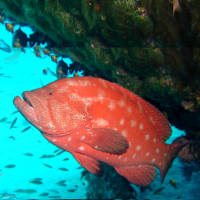
ปลากะรังหัวลาย
ขนาด: 58เซนติเมตร / พบเห็นไม่บ่อย / พฤติกรรม: เฉยเมย
ปลาสินสมุทร
ปลาสินสมุทรทะเล พวกมันถูกพบในแนวปะการังน้ำตื้นในเขตร้อนแอตแลนติก, อินเดียและมหาสมุทรแปซิฟิกตะวันตกส่วนใหญ่ ครอบครัวนี้มี 7สกุล และประมาณ 86 ชนิด

ปลาสินสมุทรวงฟ้า
ขนาด: 45เซนติเมตร / พบเห็นอยู่ทั่วไป / พฤติกรรม: เฉยเมย

ปลาสินสมุทรลายหกบั้ง
ขนาด: 46เซนติเมตร / พบเห็นอยู่ทั่วไป / พฤติกรรม: หวาดระเเวง

ปลาสินสมุทรเเว่นเหลือง
ขนาด: 38เซนติเมตร / พบเห็นได้ยาก / พฤติกรรม: หวาดระเเวง

ปลาสินสมุทรบั้ง
ขนาด: 25เซนติเมตร / พบเห็นได้ยาก / พฤติกรรม: เฉยเมย / มีอายุได้: 15 ปี
ปลาผีเสื้อ
ปลาผีเสื้อเป็นกลุ่มของปลาทะเลเขตร้อนที่เห็นได้ชัดเจนของตระกูลวงศ์ปลาผีเสื้อ; ปลาโนรีครีบยาว และ ปลาเเนวปะการัง รวมอยู่ในกลุ่มนี้ด้วย ประมาณ 129 สายพันธุ์ ใน 12 สกุล ส่วนใหญ่จะพบในแนวปะการังของมหาสมุทรแอตแลนติกอินเดียและมหาสมุทรแปซิฟิก มีเผ่าพันธุ์หลายคู่เกิดขึ้นในมหาสมุทรอินเดียและมหาสมุทรแปซิฟิกสมาชิก
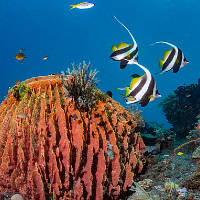
ปลาโนรีครีบยาว
ขนาด: 25เซนติเมตร / พบเห็นอยู่ทั่วไป / พฤติกรรม: เฉยเมย

ปลาผีเสื้อลายเส้น
ขนาด: 30เซนติเมตร / พบเห็นอยู่ทั่วไป / พฤติกรรม: หวาดระเเวง

ปลาผีเสื้อปากยาว
ขนาด: 20เซนติเมตร / พบเห็นอยู่ทั่วไป / พฤติกรรม: เฉยเมย

ปลาผีเสื้อคอขาว
ขนาด: 18เซนติเมตร / พบเห็นไม่บ่อย / พฤติกรรม: เฉยเมย
ปลานกแก้ว
ปลานกแก้ว เป็นกลุ่มปลาประมาณ 95 ชนิด ที่ถือว่าเป็นตระกูล (วงศ์ปลานกแก้ว) หรืออนุวงศ์ ของวงศ์ปลาขุนทอง มีประมาณ 95 สายพันธุ์ ความมากหลายสายพันธุ์ที่ใหญ่ที่สุดของกลุ่มนี้อยู่ในอินโดแปซิฟิก พบได้ในแนวปะการังชายฝั่งหิและบริเวณพื้นหญ้าทะเล และปลานกแก้วยังมีบทบาทสำคัญในการย่อยสลายทางชีวภาพทางทะเลอีกด้วย.

ปลานกแก้วหัวค้อน
ขนาด: 1.3เมตร / พบเห็นได้ยาก / พฤติกรรม: หวาดระเเวง

ปลานกแก้วหัวตัด
ขนาด: 70เซนติเมตร / พบเห็นได้มาก / พฤติกรรม: เฉยเมย
ปลาวัว
ปลาวัว มีอยู่ประมาณ 40 สายพันธุ์ ส่วนใหญ่เป็นปลาที่มีลายเส้นและจุดสีสันสดใส เป็นวงศ์ของปลากระดูกแข็งทะเลวงศ์หนึ่ง อยู่ในอันดับปลาปักเป้า มีรูปร่างโดยรวม ลำตัวกว้างแบนเป็นทรงกลมรีคล้ายรูปไข่ ข้างตำแหน่งตาอยู่สูงบริเวณด้านบนของหัว ที่ครีบหลังอันแรกจะมีหนามแข็ง 3 อัน สามารถพับเก็บได้ และจะตั้งขึ้นได้เพื่อใช้ในการข่มขู่ศัตรู
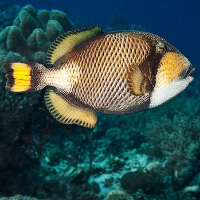
ปลาวัวยักษ์
ขนาด: 85เซนติเมตร / พบได้ทั่วไป / พฤติกรรม: ก้าวร้าว

ปลาวัวปีกัสโซ่แถบขาว
ขนาด: 30เซนติเมตร / พบเห็นได้ยาก / พฤติกรรม:ก้าวร้าว
ปลาวัวจมูกยาว
ปลาวัวจมูกยาว (วงศ์ปลาวัวจมูกยาว) เป็นวงศ์ของปลากระดูกแข็งในอันดับปลาปักเป้า มีรูปร่างโดยรวม คือ มีผิวหนังที่หยาบ มีเกล็ดเล็กละเอียดปกคลุมทั้งตัว ครีบหลังแบ่งเป็น 2 ตอน มีก้านครีบหลังก้านแรกเป็นแท่งกระดูกใหญ่ ซึ่งแหลมและแข็งแรงคล้ายเขาสัตว์ ซึ่งสามารถใช้ยกขึ้นเพื่อป้องกันตัวเองได้ อาศัยอยู่ในมหาสมุทรแอตแลนติกแปซิฟิกและมหาสมุทรอินเดีย ปลาวัวจมูกยาวมีความสัมพันธ์อย่างใกล้ชิดกับ ปลาวัว, ปลาปักเป้าและปลาสวยงาม

ปลาวัวหางยาว
ขนาด: 1.1เมตร / พบเห็นได้ทั่วไป / พฤติกรรม: เฉยเมย

ปลาวัวเล็ก
ขนาด: 31เซนติเมตร / พบเห็นได้ไม่บ่อย / พฤติกรรม: เฉยเมย
ปลาปักเป้า
มีอยู่หลายชนิด หลายวงศ์ หลายสกุล อาศัยอยู่ทั้งในทะเล น้ำกร่อย และน้ำจืด โดยมากมีลำตัวกลม ครีบและหางเล็ก จึงว่ายน้ำได้เชื่องช้าดูน่ารัก หัวโต ฟันแหลมคมใช้สำหรับขบกัดสัตว์น้ำมีเปลือกต่าง ๆ เป็นอาหาร เมื่อตกใจหรือข่มขู่สามารถสูดน้ำหรือลมเข้าช่องท้องให้ตัวพองออกได้คล้ายลูกโป่ง ในบางชนิดมีหนามด้วย

ปลาปักเป้าหนามทุเรียนปานดำ
ขนาด: 65เซนติเมตร / พบเห็นได้ทั่วไป / พฤติกรรม: เฉยเมย

ปลาปักเป้ายักษ์
ขนาด: 1.2เมตร / พบเห็นได้ทั่วไป / พฤติกรรม: เฉยเมย
ปลาแพะ และ ปลาพื้นทะเลอื่น
เป็นวงศ์ของปลาทะเลและปลาน้ำกร่อยกระดูกแข็ง ในอันดับปลากะพง มีรูปร่างโดยรวม คือ มีเกล็ดขนาดใหญ่มีลักษณะเป็นแบบสากเล็กน้อย ส่วนหัวมีเกล็ด ครีบหลังมีสองตอน มีครีบหางแบบเว้าลึก ใต้คางมีหนวด 1 คู่ ที่ไวต่อความรู้สึก ใช้สำหรับคุ้ยเขี่ยหาอาหารตามหน้าดิน
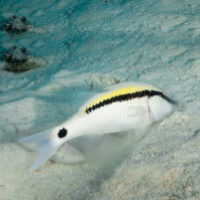
ปลาแพะแถบหางจุด
ขนาด: 60เซนติเมตร / พบเห็นได้ทั่วไป / พฤติกรรม: เฉยเมย
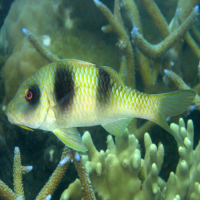
ปลาแพะบั้ง
ขนาด: 35เซนติเมตร / พบเห็นได้ทั่วไป / พฤติกรรม:เฉยเมย

ปลาดุกปิ่นเเก้ว
ขนาด: 32เซนติเมตร / พบเห็นได้ไม่บ่อย / พฤติกรรม: เฉยเมย / ความเป็นอันตราย: เงี่ยงมีพิษ

ปลาแมนดาริน
ขนาด: 7เซนติเมตร / พบเห็นได้ยาก / พฤติกรรม: เฉยเมย
ปลาลำตัวยาว และ ปลารูปร่างประหลาด
ปลาจิ้มฟันจระเข้ ปลากระดูกแข็งจำพวกหนึ่ง ซึ่งอยู่วงศ์เดียวกับม้าน้ำและมังกรทะเล มีลักษณะและพฤติกรรมโดยรวมคล้ายกับปลาชนิดอื่นและสกุลอื่นที่อยู่ในวงศ์เดียวกัน กล่าวคือ มีปากที่ยื่นเป็นท่อ ลำตัวหน้าตัดเป็นเหลี่ยม แต่ยาวเรียวมากดูคล้ายกิ่งไม้ ผิวหนังเป็นแผ่นแข็งเรียงต่อกันเป็นเหลี่ยมเป็นข้อ ครีบต่าง ๆ มีขนาดเล็ก ไม่มีครีบท้อง ตัวผู้ทำหน้าที่ฟักไข่โดยเก็บไว้บริเวณหน้าท้อง
ม้าน้ำ เป็นปลากระดูกแข็งที่อาศัยอยู่ในทะเลจำพวกหนึ่ง จัดอยู่ในวงศ์ย่อย Hippocampinae (ซึ่งมีอยู่ 2 สกุล คือหนึ่งสกุลนั้นคือ ปลาจิ้มฟันจระเข้สัน ที่อยู่ในสกุล Histiogamphelus มีรูปร่างคล้ายปลาจิ้มฟันจระเข้ผสมกับม้าน้ำ) ในวงศ์ Syngnathidae อันเป็นวงศ์เดียวกับปลาจิ้มฟันจระเข้และมังกรทะเล

ปลาจิ่มฟันจระเข้หางพัด
ขนาด: 19เซนติเมตร / พบเห็นได้ไม่บ่อย / พฤติกรรม: เฉยเมย

ปลาใบมีดโกน
ขนาด: 15เซนติเมตร / พบเห็นทั่วไป / พฤติกรรม:เฉยเมย

ปลาม้าน้ำจุด
ขนาด: 30เซนติเมตร / พบเห็นได้ยาก / พฤติกรรม: เฉยเมย
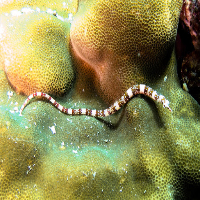
ปลาจิ้มฟันจระเข้ปล้องดำ
ขนาด: 10เซนติเมตร / พบเห็นได้ยาก / พฤติกรรม: เฉยเมย
ปลาตั๊กแตนหินและ ปลาบู่
“ปลาตั๊กแตนหิน” หรือ”ปลาตุ๊ดตู่” จากพฤติกรรมที่อาศัยและมุดไปมาอยู่ในรู เหมือนกับตุ๊ดตู่ มีลักษณะโดยรวม คือ มีลำตัวกลมยาวคล้ายปลาไหลหรือปลาบู่ แต่สั้นกว่ามาก ดวงตากลมโต ปากกว้าง ครีบหลังยาวต่อกันไปตลอดความยาวของลำตัว อาศัยอยู่ในรูหรือซอกหิน หรือเปลือกหอยที่ว่างเปล่า โดยจะโผล่มาแต่ส่วนหัวเพื่อสังเกตการณ์
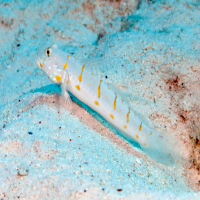
ปลาบู่ทรายหลังจุด
ขนาด: 20เซนติเมตร / พบเห็นได้ทั่วไป / พฤติกรรม: เฉยเมย

ปลาตั๊กแตนหินเสือดาว
ขนาด: 15เซนติเมตร / พบเห็นได้ยาก / พฤติกรรม: หวาดระแวง

ปลาตั๊กแตนหินหูดำ
ขนาด: 9เซนติเมตร / พบเห็นได้ทั่วไป / พฤติกรรม: หวาดระแวง
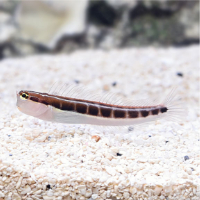
ปลาตั๊กแตนหินลายแถบ
ขนาด: 9เซนติเมตร / พบเห็นได้ทั่วไป / พฤติกรรม: หวาดระแวง
ปลาปากคม
โดยทั่วไปแล้วปลาปากคม มีขนาดเล็กถึงแม้ว่าชนิดพันธุ์ที่ใหญ่ที่สุดมีความยาวประมาณ 60 เซนติเมตร พวกมันมีลำตัวที่ค่อนข้างเรียวทรงกระบอกและหัวที่ดูเผินๆคล้ายกับพวกกิ้งก่า ครีบหลังตั้งอยู่ตรงกลางหลังและมีครีบครีบเล็ก ๆ วางไว้ใกล้กับหาง พวกเขามีปากที่เต็มไปด้วยฟันแหลมคมแม้แต่ที่ลิ้น

ปลาปากคมลาย
ขนาด: 40เซนติเมตร / พบเห็นได้ทั่วไป / พฤติกรรม: เฉยเมย
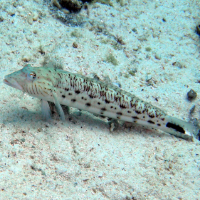
ปลาตาแหงนหางปานดำ
ขนาด: 30เซนติเมตร / พบเห็นได้ทั่วไป / พฤติกรรม: เฉยเมย

ปลามุดทรายจุด
ขนาด: 22เซนติเมตร / พบเห็นได้ไม่บ่อย / พฤติกรรม:หวาดระแวง

ปลาบู่ลูกดอกสีเพลิง
ขนาด: 9เซนติเมตร / พบเห็นได้ยาก / พฤติกรรม: หวาดระแวง
ปลาแมงป่อง และ ปลาสิงโต
วงศ์ปลาแมงป่อง หรือ วงศ์ปลาสิงโต เป็นวงศ์ของปลากระดูกแข็งทะเล หาได้ยากในน้ำจืด ในอันดับปลาแมงป่อง เป็นปลาที่เป็นที่รู้จักกันดีในอันดับนี้ มีครีบต่าง ๆ ใหญ่ โดยเฉพาะครีบอก ลำตัวหนาและแบนข้าง หลายชนิดมีสีสันสวยงาม บางชนิดมีลักษณะที่กลมกลืนไปกับสภาพแวดล้อม ส่วนหัวมีหนามหรือมีเงี่ยง ก้านครีบแข็งต่าง ๆ มีพิษ ซึ่งพิษเหล่านี้ร้ายแรงมาก เป็นสารประกอบโปรตีน ผู้ที่โดนทิ่มจะรู้สึกเจ็บปวดแสบร้อนมาก ซึ่งพิษนี้มีไว้สำหรับการป้องกันตัว มิได้มีไว้เพื่อล่าเหยื่อแต่ประการใด ส่วนมากมักจะอาศัยและหากินบริเวณพื้นน้ำ โดยอาจพบได้ลึกถึง 2,200 เมตร โดยกินปลาขนาดเล็กและสัตว์น้ำมีเปลือกเป็นอาหาร

ปลาแมงป่องเกล็ดเล็ก
ขนาด: 13เซนติเมตร / พบเห็นได้ทั่วไป / พฤติกรรม: เฉยเมย / มีความเป็นอันตราย: หนามพิษร้ายแรง

ปลาสิงโตครีบจุด
ขนาด: 20เซนติเมตร / พบเห็นได้ทั่วไป / พฤติกรรม: เฉยเมย / มีความเป็นอันตราย:หนามพิษร้ายแรง

ปลาสิงโต
ขนาด: 38เซนติเมตร / พบเห็นได้ทั่วไป / พฤติกรรม: เฉยเมย / มีความเป็นอันตราย: หนามพิษร้ายแรง
สัตว์ครึ่งบกครึ่งน้ำ
เต่าทะเลมีกระดองเป็นเกล็ดปกคลุมร่างกายซึ่งได้วิวัฒนาการให้มีลักษณะเหมาะกับการว่ายน้ำ มีรูปทรงรีหรือรูปหัวใจ แต่ทว่าทั้งหัวและขาของเต่าทะเลนั้นไม่สามารถที่จะหดเข้าไปในกระดองได้ ขาทั้งสี่ข้างถูกพัฒนาให้แบนคล้ายพายเพื่อช่วยในการว่ายน้ำให้ดียิ่งขึ้น โดยขาคู่หน้าใช้ในการผลักดันและพุ้ยน้ำ ส่วนคู่หลังใช้เป็นเหมือนหางเสือกำหนดทิศทาง เต่าทะเลบางตัวสามารถที่จะว่ายน้ำได้เร็วถึง 35 ไมล์ต่อชั่วโมง
งูทะเลทั่วโลกมีทั้งหมดประมาณ 50 ชนิด พบตั้งแต่มหาสมุทรแปซิฟิกและมหาสมุทรอินเดีย เชื่อว่าเป็นงูบกที่พัฒนาการลงมาสู่น้ำ โดยปกติ งูทะเลจะอาศัยอยู่ตามชายฝั่งน้ำตื้นที่อบอุ่น หากินปลาเป็นอาหารหลัก มีรูปร่างคล้ายงูบก แต่มีส่วนที่แตกต่างออกไปคือ เกล็ด บางชนิดมีเกล็ดเป็นมัน บางชนิดมีเกล็ดฝังอยู่ใต้ผิวหนัง ลำตัวลื่นคล้ายปลา หางแบนราบคล้ายใบพาย

เต่ามะเฟือง
ขนาด: 2เมตร / พบเห็นได้ยาก / พฤติกรรม: หวาดระแวง

เต่าตะนุ
ขนาด: 1.2เมตร / พบเห็นได้บางครั้ง / พฤติกรรม: เฉยเมย
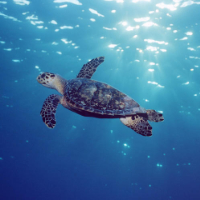
เต่ากระ
ขนาด: 1เมตร / พบเห็นได้ทั่วไป / พฤติกรรม: เฉยเมย

งูทะเลปล้องน้ำเงินดำ
ขนาด: 1.1เมตร / พบเห็นได้ยาก / พฤติกรรม: เฉยเมย / มีความเป็นอันตราย: มีพิษ
กุ้ง
กุ้ง จัดอยู่ในสัตว์ไม่มีกระดูกสันหลัง กุ้งเป็นสัตว์น้ำ หายใจด้วยเหงือก ลำตัวยาว แบนหรือกลม แบ่งเป็นปล้อง ๆ เปลือกที่หุ้มท่อนหัวและอกคลุมมาถึงอกปล้องที่ 8 ส่วนใหญ่กรีมีลักษณะแบนข้าง ก้ามและขาอยู่ที่ส่วนหัวและอก มี 10 ขา มีทั้งในน้ำจืดและน้ำเค็ม โดยปกติชอบหลบซ่อนตัวอยูเงียบ ๆ ตามพื้นน้ำหรือในซอกมืด ๆ จะออกหากินในเวลากลางคืน กุ้งกินทั้งพืชและสัตว์เป็นอาหาร กุ้งมีบทบาทสำคัญในห่วงโซ่อาหารและเป็นแหล่งอาหารที่สำคัญสำหรับสัตว์ใหญ่ตั้งแต่ปลาไปจนถึงปลาวาฬ กุ้งหลายชนิดนั้นกินได้และพวกมันถูกจับ และเพาะเลี้ยงเพื่อการบริโภคของมนุษย์
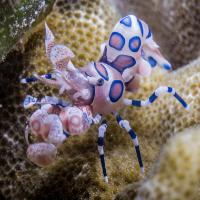
กุ้งตัวตลก
ขนาด: 5เซนติเมตร / พบเห็นได้ยาก / พฤติกรรม: หวาดระแวง

กุ้งมดเเดง
ขนาด: 5เซนติเมตร / พบเห็นได้ทั่วไป / พฤติกรรม:เฉยเมย

กุ้งหินอ่อนหัวโต
ขนาด: 4เซนติเมตร / พบเห็นได้ยาก / พฤติกรรม: เฉยเมย
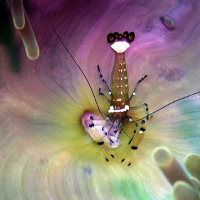
กุ้งดอกไม้ทะเลหางนกยูง
ขนาด: 4เซนติเมตร / พบเห็นได้ทั่วไป / พฤติกรรม: เฉยเมย
ปู
ปู เป็นสัตว์พวกเท้าปล้องชนิดหนึ่ง มีลักษณะสิบขา มีหลายชนิดที่อยู่ทั้งน้ำจืดและทะเล รวมถึงอยู่แต่เฉพาะบนบก ปูจะมีกระดองซึ่งเป็นแคลเซียมแข็ง มีก้ามใหญ่ 1 คู่ มีขาเดิน 4 คู่ แตกออกเป็นรัศมีไปทางด้านข้างลำตัว หนวดคู่ที่ 2 อยู่ระหว่างตา ปูในแนวปะการังมีหลายกลุ่มหลายรูปร่างโดยสัมพันธ์กับพฤติกรรม หลายชนิดอาศัยตามพื้นทราย บางชนิดตัวใหญ่ มีกระดองแข็ง มีขาสั้นและแข็งแรงเพื่อเกาะยึดกับหิน บางชนิดมีรูปร่างแปลกเพื่อพรางตัวเข้ากับสภาพแวดล้อม บางชนิดมีสีและลักษณะกระดองเหมือนกัลปังหา ปะการังอ่อน หรือดาวขนนก ในจำนวนนี้ยังมีปูที่นำฟองน้ำหรือสาหร่ายมาติดตามตัวเพื่อใช้พรางกาย ปูกลุ่มหนึ่งที่มีวิวัฒนาการมากกว่ากลุ่มอื่นคือ ปูเสฉวนจะเปลี่ยนส่วนท้องให้นิ่มและขดงอเพื่อสามารถเข้าไปอยู่ในเปลือกหอย

ปูใบ้ปะการังจุด
ขนาด: 17เซนติเมตร / พบเห็นได้ทั่วไป / พฤติกรรม: เฉยเมย
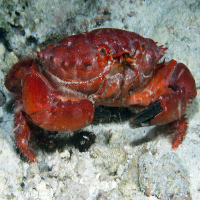
ปูใบ้ขอบแดง
ขนาด: 15เซนติเมตร / พบเห็นได้ทั่วไป / พฤติกรรม: เฉยเมย

ปูจั๊กจั่น
ขนาด: 15เซนติเมตร / พบเห็นได้ยาก / พฤติกรรม:หวาดระแวง

ปูเสฉวนขนเหลือง
ขนาด: 12เซนติเมตร / พบเห็นได้ทั่วไป / พฤติกรรม:หวาดระแวง
หอยฝาคู่
หอยฝาคู่ หรือ หอยสองฝา หรือ หอยเปลือกคู่ หรือ หอบกาบคู่ มีลักษณะทั่วไป คือ มีฝาสองข้างประกบเข้าด้วยกัน สามารถเปิดปิดได้ โดยมีโครงสร้างของจุดเชื่อมต่อคล้ายฟันสลักบานพับประตูที่ขั้วฝาทั้งสองที่ขบเกี่ยวกัน บางชนิดยึดติดเปลือกข้างหนึ่งไว้กับพื้นผิวที่แข็ง ใช้เหงือกกรองอาหารกินจากกระแสน้ำที่พัดผ่าน บางชนิดฝังตัวอยู่ใต้ทรายตลอดทั้งชีวิต โดยใช้เนื้อเท้าที่มีรูปร่างคล้ายใบขวานขุดแซะ เพื่อแทรกตัวลงไปใต้พื้นทราย โดยมีท่อน้ำดูดน้ำเข้าออกกรองอาหารกิน บางชนิดฝังตัวใต้ซากไม้ที่ผุพัง และบางชนิดก็ซุ่มซ่อนตัวเพื่อล่าเหยื่อ ขณะที่บางกลุ่มสามารถเปิดฝาปิดนี้อ้าและหุบเป็นจังหวะ เพื่อพ่นขับแรงดันน้ำจนเสมือนกับว่าได้ว่ายน้ำได้

หอยมือเสือ
ขนาด: 1.4เมตร / พบเห็นได้ทั่วไป / มีอายุได้: 100 ปี

หอยมุก
ขนาด: 30เซนติเมตร / พบเห็นได้ทั่วไป

หอยพัดปะการัง
ขนาด: 6เซนติเมตร / พบเห็นได้ทั่วไป

หอยไฟฟ้าเต้นรำ
ขนาด: 3เซนติเมตร / พบเห็นได้ยาก
หอยฝาเดียว
หอยฝาเดียว หรือ หอยกาบเดียว หรือ หอยเปลือกเดียว ได้พัฒนารูปร่างและวิถีการดำรงชีวิตให้อาศัยอยู่ได้ทั้งในน้ำจืดและทะเลรวมถึงบนบก บนต้นไม้ หรือแม้กระทั่งในทะเลทรายอีกด้วย มีกล้ามเนื้อบริเวณเท้าแข็งแรงและหนาแน่น พบกระจายพันธุ์อยู่ทั่วโลก มีลักษณะเปลือกตอนท้ายวนเป็นเกลียวซึ่งประกอบไปด้วยหินปูนเป็นสำคัญ มีเปลือกบาง ๆ ชิ้นหนึ่งปิดตอนต้นของฝาเรียกว่า “โอเพอร์คูลัม” (Operculum) มีส่วนหัวเจริญดี มีหนวด 1-2 คู่ มีตา ภายในปากมีแรดูลาใช้สำหรับบดอาหาร หายใจด้วยเหงือกหรือปอดหรือแมนเทิล มีไตเป็นอวัยวะขับถ่าย
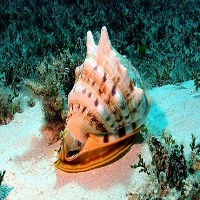
หอยตีนช้าง
ขนาด: 40เซนติเมตร / พบเห็นได้ทั่วไป

หอยสังข์หนามกิ่งกุหลาบ
ขนาด: 13เซนติเมตร / พบเห็นได้ทั่วไป

หอยเต้าปูน
ขนาด: 15เซนติเมตร / พบเห็นได้ทั่วไป / มีความเป็นอันตราย: หนามทิ่มแทง/มีพิษอันตรายถึงชีวิต

หอยเบี้ยลายแผนที่
ขนาด: 10เซนติเมตร / พบเห็นได้ทั่วไป
ทากเปลือย
ทากทะเล (อังกฤษ: Nudibranch, Sea slug) เป็นสัตว์ไม่มีกระดูกสันหลังจำพวกมอลลัสกา เช่นเดียวกับหอย และหมึก จัดอยู่ในชั้นหอยฝาเดี่ยว ในอันดับย่อย Nudibranchia มีลักษณะเด่น คือ ไม่มีเปลือกห่อหุ้มลำตัว เพราะเปลือกลดรูปจนมีขนาดเล็กคลุมตัวไม่มิด หรือไม่มีเปลือกเลย ทากทะเลส่วนใหญ่มีสีสวยสดงดงาม และสามารถปรับสีของตัวให้เข้ากับสภาพของแหล่งอาศัย สีที่ฉูดฉาดทำให้สัตว์อื่นหลีกเลี่ยงที่จะกินเป็นอาหาร เพราะทากทะเลจะสร้างสารเคมีที่เป็นพิษสะสมไว้ตามผิว เพื่อป้องกันตัว บางชนิดมีอวัยวะช่วยหายใจอยู่ทางด้านบนของหัวหรือลำตัว ซึ่งอาจมีลักษณะเป็นเส้น เป็นกระจุก หรือเป็นแผ่น หรือคล้ายเขา และเป็นสัตว์ที่ไม่มีตาสำหรับการมองเห็น กินอาหารพวกสาหร่าย, ฟองน้ำ, ดอกไม้ทะเล, ปะการังอ่อน, กัลปังหา และเพรียงหัวหอม ทั่วโลกพบประมาณ 2,000 ชนิด ในน่านน้ำไทยสำรวจพบประมาณ 100 ชนิด เช่น ทากเปลือย เป็นต้น

ทากเปลือยยักษ์เเถบเเดง
ขนาด: 30เซนติเมตร / พบเห็นได้ยาก

ทากเปลือยดำลายเขียว
ขนาด: 12เซนติเมตร / พบเห็นได้ยาก

ทากปุ่มทองขีดดำ
ขนาด: 11เซนติเมตร / พบเห็นได้ทั่วไป

ทากเปลือยขอบเรียบ
ขนาด: 5เซนติเมตร / พบเห็นได้ยาก
ปลาหมึก
เป็นสัตว์ทะเลที่ไม่มีกระดูกสันหลัง เคลื่อนที่ได้รวดเร็ว และว่องไว มีหนวดรอบปาก 4-5 คู่ บนหนวดมีปุ่มดูดเรียงเป็นแถว มีหน้าที่จับเหยื่อป้อนเข้าปาก หมึกส่วนใหญ่มีกระดูกหรือเปลือกอยู่ภายในเพื่อใช้ประโยชน์ในการเป็นทุ่นหรือพยุงร่างกาย ซึ่งเรียกว่า ลิ้นทะเล ยังมีบางชนิดที่ไม่มีกระดูก แต่มีกระดูกอ่อนทดแทนเพื่อใช้ในการพยุงโครงสร้างร่างกาย

ปลาหมึกสายลายเสือ
ขนาด: 60เซนติเมตร / พบเห็นได้ยาก

หมึกกระดองมือยาว
ขนาด: 50เซนติเมตร / พบเห็นได้ทั่วไป

ปลาหมึกหอม
ขนาด: 45เซนติเมตร / พบเห็นทั่วไป
ปลิงทะเล
ปลิงทะเล (อังกฤษ: sea cucumber) เป็นสัตว์ทะเลที่ไร้กระดูกสันหลังชนิดหนึ่ง จัดอยู่ในตระกูลเดียวกับดาวทะเลและหอยเม่น มีรูปร่างกลมยาว คล้ายไส้กรอกขนาดใหญ่ ปลายทั้งสองข้างเป็นช่องเปิดของปากและทวาร ผิวหนังส่วนนอกคล้ายเนื้อยืดหยุ่นได้ ภายในผิวหนังมีตุ่มเม็ดหินปูนกระจายอยู่ทั่วไปตามผิวนอกมีติ่งเนื้อเล็ก ๆ คล้ายหนวดสั้น ๆ เรียงอยู่เป็นแถว ทำหน้าที่ช่วยในการหายใจและเคลื่อนไหว ปลิงมีสารพิษ โฮโลทูลิน ซึ่งปล่อยออกทางผิวหนัง ใช้ในการป้องกันอันตรายจากปลาและปู พบอาศัยตามพื้นทะเลที่เป็นทรายปนโคลนใน อ่าวไทยและทะเลอันดามัน อาหาร กินอินทรีย์วัตถุตามพื้นดินโคลนและทราย

ปลิงทะเลเหลี่ยม
ขนาด: 55เซนติเมตร / พบเห็นได้ทั่วไป

ปลิงทะเลจุดทองดำ
ขนาด: 70เซนติเมตร / พบเห็นได้ทั่วไป
เม่นทะเล
เม่นทะเล หรือ หอยเม่น (อังกฤษ: sea urchin) เป็นสัตว์ที่มีทรงกลมและมักมีหนาม มีราว 950 สายพันธุ์ อาศัยอยู่ตามพื้นทะเล เปลือกนอกมีลักษณะแข็ง กลม และมีหนาม มีขนาดเส้นผ่่านศูนย์กลางลำตัวตั้งแต่ 3 ซม. ถึง 10 ซม. เม่นทะเลเคลื่อนที่ได้อย่างช้าๆด้วยขาท่อและบางครั้งยังเคลื่อนที่ด้วยหนามของมัน อาหารหลักของเม่นทะเลคือสาหร่ายต่างๆ แต่ก็กินสัตว์ที่เคลื่อนที่ช้าหรืออยู่กับที่ด้วย นักล่าที่กินเม่นทะเลเป็นอาหารได้แก่ นากทะเล, ปลาดาว, ปลาไหลหมาป่า(wolf eels) และปลาวัว(trigger fish)

เม่นทะเลหนามยาว
ขนาด: 60เซนติเมตร / พบเห็นได้ทั่วไป / มีความเป็นอันตราย: หนามทิ่มแทง/เจ็บปวด

เม่นทะเลแต่งตัว
ขนาด: 15เซนติเมตร / พบเห็นได้ทั่วไป / มีความเป็นอันตราย:หนามทิ่มแทง/เจ็บปวด
ปลาดาว
ดาวทะเล หรือ ปลาดาว เป็นสัตว์ทะเลไม่มีกระดูกสันหลัง ลักษณะทั่วไป มีลำตัวแยกเป็นห้าแฉกคล้ายรูปดาวเรียกว่า แขน ส่วนกลาง มีลักษณะเป็นจานกลม ด้านหลังมีตุ่มหินปูน ขนาดเล็กกระจายอยู่ทั่วไป มีปากอยู่ด้านล่างบริเวณ จุดกึ่งกลางของ ลำตัว ใต้แขนแต่ละข้างมีหนวดสั้น ๆ เรียงตามส่วนยาว ของแขนเป็นคู่ ๆ มีลักษณะเป็นกล้ามเนื้อที่เหนียวและแข็งแรงเรียกว่า โปเดีย ใช้สำหรับยึดเกาะกับเคลื่อนที่ มีสีต่าง ๆ ออกไป ทั้ง ขาว, ชมพู, แดง, ดำ, ม่วง หรือน้ำเงิน เป็นต้น กินหอยสองฝา โดยเฉพาะ หอยนางรม, กุ้ง, ปู หนอน และ สัตว์ไม่มีกระดูกสันหลังอื่น ๆ เช่น ฟองน้ำหรือปะการัง เป็นอาหาร
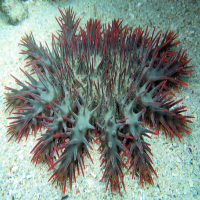
ปลาดาวหนาม
ขนาด: 50เซนติเมตร / พบเห็นได้ทั่วไป / มีความเป็นอันตราย: หนามทิ่มแทง/เจ็บปวด

ปลาดาวหมอนปักเข็ม
ขนาด: 30เซนติเมตร / พบเห็นได้ทั่วไป
หนอนตัวแบน
หนอนตัวแบน ลักษณะคล้ายริบบิ้น ผิวลำตัวอ่อนนิ่ม ยกเว้นพวกที่เป็นปรสิตจะมีคิวติเคิลหนา พบประมาณ 25000 ชนิด จัดอยู่ในสัตว์กลุ่มที่ไม่มีช่องว่างลำตัวที่แท้จริง (Accoelomate) กลุ่มใหญ่ที่สุด สามารถพบได้ทั้งในทะเล น้ำจืด บนบก ส่วนใหญ่ดำรงชีวิตแบบปรสิต (parasitic) บางวงศ์ดำรงชีวิตอิสระ (free living) ส่วนใหญ่มีขนาดเล็ก และสั้น ยกเว้นพยาธิตัวตืด ขนาดและความยาวแตกต่างกันไปตามแต่ชนิด พบยาวที่สุดกว่า 20 เมตร

หนอนตัวแบนดำขอบทอง
ขนาด:7เซนติเมตร / พบเห็นได้ยาก

หนอนตัวแบนด่างขาวขอบทอง
ขนาด: 6เซนติเมตร / พบเห็นได้หายาก

หนอนทัวแบนจุดส้มขอบฟ้า
ขนาด: 6เซนติเมตร / พบเห็นได้ยาก

หนอนตัวแบนม่วงขอบทอง
ขนาด: 6เซนติเมตร / พบเห็นได้ยาก

หนอนตัวแบนดอกไม้เหลือง
ขนาด: 4เซนติเมตร / พบเห็นได้บางครั้ง
หนอนพู่ฉัตร
หนอนพู่ฉัตร เป็นหนอนปล้องที่มีลำตัวยาวเป็นทรงกระบอก ลักษณะเด่นของเจ้าหนอนชนิดนี้คือ มีเกลียวพู่หลากหลายสีสันด้วยกัน ทั้งแดง เหลือง ส้ม ฟ้า น้ำเงิน น้ำตาล และขาว บานได้หุบได้ แต่งแต้มสีสันอยู่ตามโขดหินใต้ทะเล เจ้าเกลียวพู่นี้จะช่วยในการรับอาหารที่พัดลอยมาตามกระแสน้ำ ขณะเดียวกันที่เกลียวเหล่านี้ก็จะมีเส้นขนเล็กเรียงรายอยู่ เพื่อช่วยในการพยุงตัวอยู่ในน้ำ เนื่องจากเจ้าหนอนชนิดนี้ไม่มีอวัยวะพิเศษที่ช่วยในการว่ายน้ำนั่นเอง นอกจากนี้แล้ว ท่อหลากสีของมันนี้ยังช่วยเรื่องการหายใจอีกด้วย ดังนั้นหากเรียกชื่อมันตามโครงสร้างทั่วไปแล้วเจ้าท่อเหล่านี้ก็คือเหงือกของมันนั่นเอง

หนอนฉัตรขนนก
ขนาด: 10เซนติเมตร / พบเห็นได้ทั่วไป

หนอนฉัตรพัดแดง
ขนาด: 6เซนติเมตร / พบเห็นได้ทั่วไป

หนอนฉัตรต้นคริสมาส
ขนาด: 4เซนติเมตร / พบเห็นได้ทั่วไป
ปะการังแบบกิ่ง
ปะการัง หรือ กะรัง เป็นสิ่งมีชีวิตที่อาศัยอยู่ในทะเล จัดอยู่ในชั้นแอนโธซัวและจัดเป็นพวกดอกไม้ทะเล มีขนาดเล็กเรียกว่าโพลิฟ แต่จะอาศัยรวมกันอยู่เป็นโคโลนีที่ประกอบไปด้วยโพลิฟเดี่ยว ๆ จำนวนมาก เป็นกลุ่มที่สร้างแนวปะการังที่สำคัญพบในทะเลเขตร้อนที่สามารถดึงสารแคลเซียมคาร์บอเนตจากน้ำทะเลมาสร้างเป็นโครงสร้างแข็งเพื่อเป็นที่อยู่อาศัยได้ หัวของปะการังหนึ่ง ๆ โดยปกติจะสังเกตเห็นเป็นสิ่งมีชีวิตเดี่ยว ๆ อันหนึ่ง แต่ที่จริงนั้นมันประกอบขึ้นมาจากสิ่งมีชีวิตเดี่ยวๆขนาดเล็กนับเป็นพัน ๆ โพลิฟโดยในทางพันธุ์ศาสตร์แล้วจะเป็นโพลิฟชนิดพันธุ์เดียวกันทั้งหมด โพลิฟจะสร้างโครงสร้างแข็งที่มีลักษณะเฉพาะของปะการังแต่ละชนิด หัวของปะการังหนึ่ง ๆ มีการเจริญเติบโตโดยการสืบพันธุ์แบบไม่ใช้เพศของโพลิฟเดี่ยว ๆ แต่ปะการังก็สามารถสืบพันธุ์ออกลูกหลานโดยการใช้เพศกับปะการังชนิดเดียวกันด้วยการปล่อยเซลล์สืบพันธุ์พร้อม ๆ กันตลอดหนึ่งคืนหรือหลาย ๆ คืนในช่วงเดือนเพ็ญ

ปะการังเขากวางกิ่งยาว
ขนาด: 7เมตร / พบเห็นได้ทั่วไป

ปะการังเขากวางฟอร์โมซ่า
ขนาด: 1.5เมตร / พบเห็นได้ทั่วไป /ถูกคุกคาม

ปะการังเขากวางโต๊ะ
ขนาด: 80เซนติเมตร/ พบเห็นได้ทั่วไป

ปะการังเขากวางกิ่งหนา
ขนาด: 1.2เมตร / พบเห็นได้ทั่วไป

ปะการังเขากวางนิ้วมือ
ขนาด: 60เซนติเมตร / พบเห็นได้ทั่วไป

ปะการังกลีบดอกไม้แบบแท่ง
ขนาด: 2.5เมตร / พบเห็นได้ทั่วไป

ปะการังดอกกะหล่ำกิ่งใหญ่
ขนาด: 1เมตร / พบเห็นได้ทั่วไป /ถูกคุกคาม

ปะการังโขดนิ้วมือเรียบ
ขนาด: 1เมตร / พบเห็นได้ทั่วไป /ถูกคุกคาม
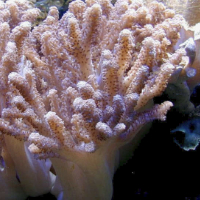
ปะการังช่องเล็กแบบนิ้วมือ
ขนาด: 50เซนติเมตร / พบเห็นได้ทั่วไป
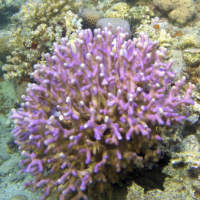
ปะการังเกล็ดคว่ำ
ขนาด: 30เซนติเมตร / พบเห็นได้ทั่วไป
ปะการังขนาดใหญ่และปะการังสมอง

ปะการังวงแหวนเล็ก
ขนาด: 1เมตร / พบเห็นได้ทั่วไป

ปะการังดาวใหญ่
ขนาด: 7เมตร / พบเห็นได้ทั่วไป /ถูกคุกคาม

ปะการังวงแหวนใหญ่
ขนาด: 1เมตร / พบเห็นได้ทั่วไป

ปะการังช่องเหลี่ยมใหญ่
ขนาด: 1.2เมตร / พบเห็นได้ทั่วไป / ถูกคุกคาม

ปะการังดอกไม้ทะเล
ขนาด: 60เซนติเมตร / พบเห็นได้ทั่วไป / ถูกคุกคาม

ปะการังถ้วยสมอง
ขนาด: 5เมตร / พบเห็นได้ทั่วไป

ปะการังลูกโป่งใหญ่
ขนาด: 2เมตร / พบเห็นได้ทั่วไป / ถูกคุกคาม

ปะการังรังผึ้งหยก
ขนาด: 2เมตร / พบเห็นได้ทั่วไป

ปะการังสมองร่องยาว
ขนาด: 2เมตร / พบเห็นได้ทั่วไป

ปะการังสมองร่องเล็ก
ขนาด: 1.5เมตร / พบเห็นได้ทั่วไป / ถูกคุกคาม
ปะการังแบบแผ่น, แบบดอกเห็ด และ ปะการังดอกไม้
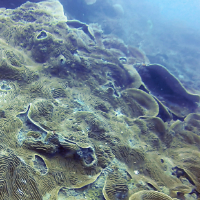
ปะการังลายลูกฟูก
ขนาด: 8เมตร / พบเห็นได้ทั่วไป

ปะการังจาน
ขนาด: 3เมตร / พบเห็นได้ทั่วไป / ถูกคุกคาม

ปะการังผักกาดหนาม
ขนาด: 2เมตร / พบเห็นได้ทั่วไป

ปะการังดอกเห็ด
ขนาด: 30เซนติเมตร / พบเห็นได้ทั่วไป
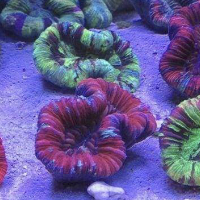
ปะการังสีมุกดา
ขนาด: 20เซนติเมตร / พบเห็นได้ทั่วไป / ถูกคุกคาม
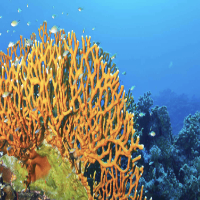
ปะการังไฟ
ขนาด: 1เมตร / พบเห็นได้ทั่วไป

ปะการังหนวดถั่ว
ขนาด: 1เมตร / พบเห็นได้ทั่วไป / ถูกคุกคาม

ปะการังถ้วยส้ม
ขนาด: 35เซนติเมตร / พบเห็นได้ทั่วไป

พรมทะเลก้านยาว
ขนาด: 30เซนติเมตร / พบเห็นได้ทั่วไป

เห็ดทะเล
ขนาด: 1เซนติเมตร / พบเห็นได้ทั่วไป
กัลปังหา และ ดอกไม้ทะเล

กัลปังหาพิณ
ขนาด: 1.5เมตร / พบเห็นได้บางแห่ง

กัลปังหายักษ์
ขนาด: 2เมตร / พบเห็นได้บางแห่ง

กัลปังหาเงื่อน
ขนาด: 1เมตร / พบเห็นได้บางแห่ง

ปะการังสีดำ
ขนาด: 3เมตร / พบเห็นได้ทั่วไป

แส้ทะเลม้วน
ขนาด: 2เมตร / พบเห็นได้บางแห่ง

ดอกไม้ทะเล
ขนาด: 1เมตร / พบเห็นได้ทั่วไป

ดอกไม้ทะเลพรมยักษ์
ขนาด: 1.2เมตร / พบเห็นได้ทั่วไป

ดอกไม้ทะเลหนวดโป่ง
ขนาด: 40เซนติเมตร / พบเห็นได้ทั่วไป

ดอกไม้ทะเลพิชซ่า
ขนาด: 35เซนติเมตร / พบเห็นได้บางแห่ง

ดอกไม้ทะเลพุ่มแหลม
ขนาด: 50เซนติเมตร / พบเห็นได้ยาก
ปะการังอ่อน และ แมงกะพรุน
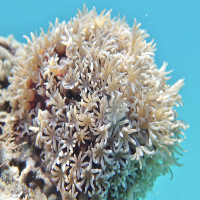
ปะการังไปพ์ออแกน
ขนาด: 1เมตร / พบเห็นได้บางแห่ง

ปะการังอ่อนทองหยิบ
ขนาด: 80เซนติเมตร / พบเห็นได้ทั่วไป

ปะการังอ่อนต้นวุ้น
ขนาด: 70เซนติเมตร / พบเห็นได้บางแห่ง

ปะการังอ่อนหนังนิ้วมือ
ขนาด: 50เซนติเมตร / พบเห็นได้ทั่วไป

ปะการังอ่อนขนนกซีเนีย
ขนาด: 20เซนติเมตร / พบเห็นได้บางแห่ง

แมงกะพรุนลายจุด
ขนาด: 3เมตร / พบเห็นได้ยาก / มีความเป็นอันตราย: ทำให้คัน

แมงกะพรุนด่างออสเตรเลีย
ขนาด: 70เซนติเมตร / พบเห็นได้ยาก / มีความเป็นอันตราย: ทำให้คัน

แมงกะพรุนไฟหมวกโปรตุเกส
ขนาด: 20เซนติเมตร / พบเห็นได้ยาก / มีความเป็นอันตราย: ทำให้คัน / อันตรายถึงชีวิต

แมงกะพรุนหัวคว่ำ
ขนาด: 30เซนติเมตร / พบเห็นได้ยาก / มีความเป็นอันตราย : ทำให้คัน

แมงกะพรุนกล่อง
ขนาด: 4เมตร / พบเห็นได้ยาก / มีความเป็นอันตราย: ทำให้คัน / อันตรายถึงชีวิต
ฟองน้ำท่อ, ฟองน้ำแจกัน, ฟองน้ำกิ่งและก้อน

ฟองน้ำท่อเเบบกิ่ง
ขนาด: 80เซนติเมตร / พบเห็นได้บางแห่ง
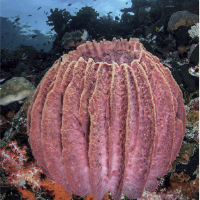
ฟองน้ำครก
ขนาด: 2เมตร / พบเห็นได้ทั่วไป

ฟองน้ำท่อใหญ่
ขนาด: 80เซนติเมตร / พบเห็นได้ยาก

ฟองน้ำท่อหนาม
ขนาด: 50เซนติเมตร / พบเห็นได้บางแห่ง

ฟองน้ำหูช้าง
ขนาด: 2เมตร / พบเห็นได้ทั่วไป

ฟองน้ำท่อพุ่มแดง
ขนาด: 10เซนติเมตร / พบเห็นได้ยาก

ฟองน้ำดำเมือกม่วง
ขนาด: 70เซนติเมตร / พบเห็นได้บางแห่ง

ฟองน้ำปล่องภูเขาไฟ
ขนาด: 1เมตร / พบเห็นได้ยาก

ฟองน้ำฝังตัวสีแดง
ขนาด: 1เมตร / พบเห็นได้ยาก

ฟองน้ำแจกันปากแคบ
ขนาด: 30เซนติเมตร / พบเห็นได้ทั่วไป
แบบทดสอบความรู้ PDF
